Petenia splendida
(Günther, 1862)
Red Bay Snook
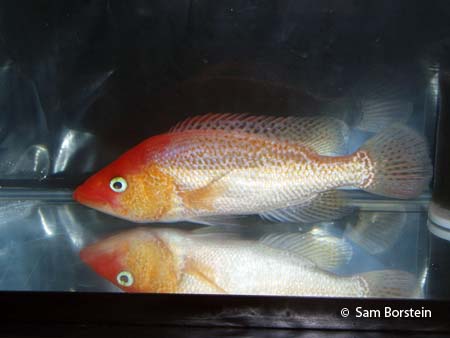
Above: A male Red Bay Snook. Photo by Sam Borstein.
Etymology:
Genus-Petenia= Named after original collection area, Lake Peten.
Species- splendida= Greek for shinning, in reference to the scales on the fish.
Intro:
The Red Bay Snook is a very neat New World cichlid. The ambush predator is not overly aggressive, but will eat anything that will fit in its mouth. The fish is nicknamed the Red Bay Snook because of its close resemblance to the salt water snook.
The fish occurs in 2 color morphs. These two morphs can be found together at the same locations:
- Green/Silver- Harder to find in the hobby, but very pretty.
- Red- Fish occur in rivers that has red lily pads. It is believed the color adaptation is to help them hunt.
Distribution:
This fish is found in Belize, Guatemala, and Mexico. The Red Bay Snook inhabits lakes as well as rivers.
Size, Maturity, and Sexual Dimorphism:
Size: Males- 20 inches, Females- 18 inches
Maturity: 5 inches
Sexual Dimorphism: Males are a little bit larger than females, and have a more intense red color. Females are usually rounder and have more girth.
Care:
Big fish equals big amounts of waste, and this is true of Petenia splendida. Although not overly aggressive, the fish do get large, and need space, so a large, roomy tank with lots of filtration is a must. Other than that, Snook Cichlids are easy to keep. Be cautious when picking tank mates as the Red Bay Snook can easily consume a fish half of its body length! Petenia splendida don't have the strongest jaws, so put it with fish that don't fight by jaw locking, as the Snooks may get injured.
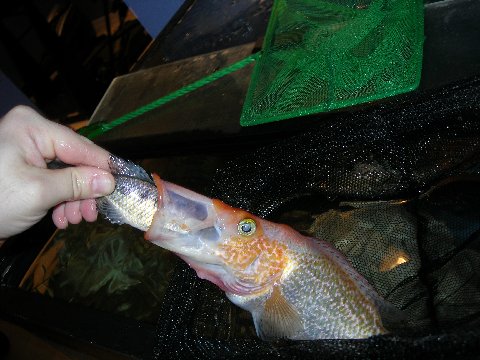
Above: Mike Helford's Snook has an expensive meal of a wild 7-8 inch Mylochromis spilostichus. Photo by Mike Helford.
Diet:
Snooks are ambush predators, and use their mouth to suck up anything that will fit. In the aquarium, Snooks will usually accept most large prepared foods like Tetra Cichlid Sticks.
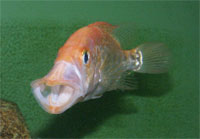
Above: The large protrusible mouth of the Snook. Photo by Rick Borstein.
Breeding:
Snooks are not overly hard to breed. I had a group of 4, 1 male and 3 females in a 110 gallon tank. The male would spawn with one of the females per week. The key thing for getting the fish to spawn are getting the females into condition, and making sure the fish have enough room to set up a breeding territory.
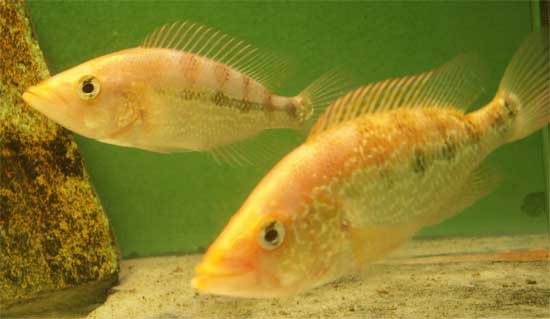
Above: A young pair of Snooks. Photo by Rick Borstein.
The fish will hold a territory for about 3-5 days pre-spawn and then breed. The amount of eggs depends on the age and size of the female, but can range from 300-2000. Before spawning the females change color pattern and develop some noticeable barring. The male will gain this color as well, but it usually is only seen after the fry are free swimming.
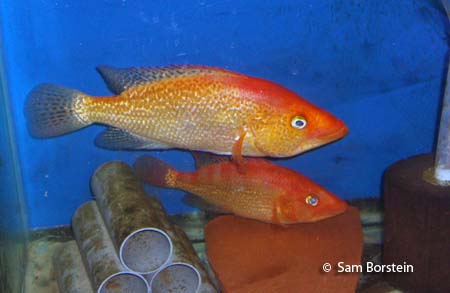
Above: The same pair of fish as above, but about 2 years older. Note the females striping on the back, a sign of spawning. Photo by Sam Borstein.
Eggs develop relatively fast and hatch by 4-5 days. In another 3, they are free swimming. The parents are good at defending the fry generally. The fry do great starting out on baby brine shrimp and then dry foods. They grow fast. The fry are highly cannibalistic, so make sure you feed enough.
Conclusion:
This fish easily makes my top 10 favorites. Not only is it peaceful, but it is beautiful. The only downside is the eventual large size. If you are a New World fan, you must give this fish a try. They are readily available from hobbyists and are occasionally seen in pet shops.
References:
- Günther, A. (1862) Catalogue of the Fishes in the British Museum. Vol. IV. British Museum, London, 534 pp.
- Miller, R.R., Minckley, W.L. & Norris, S.M. (2005) Freshwater Fishes of México. Museum of Zoology, University of Michigan, & University of Chicago Press, Chicago, 652 pp.
